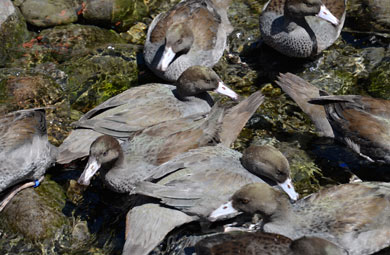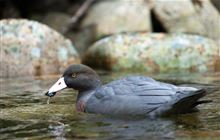Fabulous flock of whio arrive at bootcamp
Archived content: This media release was accurate on the date of publication.
Introduction
A whopping 26 whio have arrived at the Whio Hardening Facility in Turangi.Date: 15 January 2018
Last Tuesday a whopping 26 whio/blue duck flocked from all over the country to the Whio Hardening Facility at the Tongariro National Trout Centre in Turangi.
The ducks came from Wellington, Hamilton, Masterton and as far away as Christchurch and Auckland, and throughout the day visitors gathered to see the various clutches released into the two purpose-built predator-proof aviaries.

Volunteer Emma Kelman getting the ducks ready for their release into the aviaries
Image: Sarah O’Sullivan ©

The ducks settled in immediately
Image: Sarah O’Sullivan ©
Newly arrived Department of Conservation volunteer Emma Kelman, who will be caring for the ducks while they're at the facility, was excited that on her her first day on the job she got to see so many birds together: "It was fantastic to meet all the people from different parts of the country who had worked so hard to get the birds to this point – we'll take good care of them!"
The facility or "bootcamp" will be home for these captive bred birds for the next five weeks while they learn to swim and feed in fast flowing water before their release to the wild.
For an iconic New Zealand species with fewer than 3,000 birds left in the wild, the Whio Hardening Facility provides the perfect opportunity to see whio up close.
In previous seasons there was only many as fourteen ducks the aviaries at one time, so this is a great sign for the Whio Forever Project, which aims to secure the future of whio in the wild.
Once released, these ducks will give a huge boost to whio populations in Taranaki and Tongariro, making room for more birds to pass through the "bootcamp" before the season closes at the end of March.
The hardening facility is supported by a range of community groups along with Whio Forever, Genesis and DOC's national whio recovery programme.
Genesis environmental co-ordinator, Cam Speedy, was on site at the hardening facility to see the ducks arrive.
"It's not just humans who head to the central north island to upskill in outdoor pursuits. These little ducks have the perfect spot here to learn a thing or two about rapids, rocks and getting out in the wild," says Speedy.
The support of Genesis is enabling DOC to double the number of fully secure whio breeding sites throughout the country, boost pest control efforts and enhance productivity and survival for these rare native ducks.
Background information on whio
- The whio is a threatened species of native duck that is only found in New Zealand's fast flowing waters. Featured on New Zealand's $10 note and with an estimated nationwide population of less than 2,500 birds, whio are rarer than kiwi.
- Whio are adapted to live on fast-flowing rivers so finding whio means you will also find clean, fast-flowing water with a good supply of underwater insects.
- This makes whio important indicators of ecosystem health – they only exist where there is high quality clean and healthy waterways.
Whio Forever
- Genesis Energy has a strong historic association with whio through the Tongariro Power Scheme and in 2010 this association grew through the establishment of Whio Awareness Month (March).
- Today, Genesis Energy and the Department of Conservation (DOC) continue their partnership through the Whio Forever Programme, which aims to secure the future of whio in the wild and ensure New Zealanders understand and value of whio in our rivers.
- The support of Genesis Energy and the work of DOC has enabled the Whio Recovery Plan to be implemented.
Conservation issue
- The whio are eaten by stoats, ferrets and cats, with the largest impact during nesting time when eggs, young and females are vulnerable, and also when females are in moult and can't fly.
- Extensive trapping can manage these predators and work in key whio habitats by DOC and Genesis Energy on the Whio Forever Project has already seen an increase in whio numbers.
- Whio cannot be moved to predator-free islands like other species because of their reliance on large fast-flowing rivers.
- Pairs occupy approximately 1 km of water – so they need a lot of river to sustain a large population and they fiercely defend their territories, which makes it difficult to put them with other ducks in captivity.
- They are susceptible to flood events which, destroy nests, fragment broods and wash away their valued food source.

